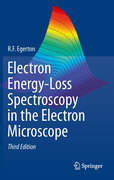
INDICE: Chapter 1. An Introduction to EELS. 1.1. Interaction of Fast Electrons with a Solid. 1.2. The Electron Energy-Loss Spectrum. 1.3. The Developmentof Experimental Techniques. 1.3.1. Energy-Selecting (Energy-Filtering) Electron Microscopes. 1.3.2. Spectrometers as Attachments to Electron Microscopes. 1.4. Alternative Analytical Methods. 1.4.1. Ion-Beam Methods. 1.4.2. Incident Photons. 1.4.3. Electron-Beam Techniques. 1.5. Comparison of EELS and EDX Spectroscopy. 1.5.1. Detection Limits and Spatial Resolution. 1.5.2. Specimen Requirements. 1.5.3. Accuracy of Quantification. 1.5.4. Ease of Use and InformationContent. 1.6. Further Reading. Chapter 2. Energy-Loss Instrumentation. 2.1. Energy-Analyzing and Energy-Selecting Systems. 2.1.1. The Magnetic-Prism Spectrometer. 2.1.2. Energy-Filtering Magnetic-Prism Systems. 2.1.3. The Wien Filter. 2.1.4. Electron Monochromators. 2.2. Optics of a Magnetic-Prism Spectrometer. 2.2.1. First-Order Properties. 2.2.2. Higher-Order Focusing. 2.2.3. Spectrometer Sesigns. 2.2.4. Practical Considerations. 2.2.5. Spectrometer Alignment. 2.3. The Use of Prespectrometer Lenses. 2.3.1. TEM Imaging and Diffraction Modes. 2.3.2. Effect of Lens Aberrations on Spatial Resolution. 2.3.3. Effect of Lens Aberrations on Collection Efficiency. 2.3.4. Effect of TEM Lenses on Energy Resolution. 2.3.5. STEM Optics. 2.4. Recording the Energy-Loss Spectrum 2.4.1. Spectrum Shift and Scanning. 2.4.2. Spectrometer Background. 2.4.3. Coincidence Counting. 2.4.4. Serial Recording of the Energy-Loss Spectrum. 2.4.5. DQE of a Single-Channel System. 2.4.6. Serial-Mode Signal Processing. 2.5. Parallel Recording of Energy-Loss Data. 2.5.1. Types of Self-Scanning Diode Array. 2.5.2. Indirect Exposure Systems. 2.5.3. Direct Exposure Systems. 2.5.4. DQE of a Parallel-Recording System. 2.5.5. Dealing with Diode Array Artifacts. 2.6.Energy-Selected Imaging (ESI). 2.6.1. Post-Column Energy Filter. 2.6.2. In-Column Filters. 2.6.3. Energy Filtering in STEM Mode. 2.6.4. Spectrum-Imaging. 2.6.5. Elemental Mapping. 2.6.6. Comparison of Energy-Filtered TEM and STEM. 2.6.7. Z -Contrast and Z-Ratio Imaging. Chapter 3. Physics of Electron Scattering. 3.1. Elastic Scattering. 3.1.1. General Formulas. 3.1.2. Atomic Models. 3.1.3. Diffraction Effects. 3.1.4. Electron Channeling. 3.1.5. Phonon Scattering.3.1.6. Energy Transfer in Elastic Scattering. 3.2. Inelastic Scattering. 3.2.1. Atomic Models. 3.2.2. Bethe Theory. 3.2.3. Dielectric Formulation. 3.2.4. Solid-State Effects. 3.3. Excitation of Outer-Shell Electrons. 3.3.1. Volume Plasmons. 3.3.2. Single-Electron Excitation. 3.3.3. Excit
- ISBN: 978-1-4419-9582-7
- Editorial: Springer US
- Encuadernacion: Cartoné
- Páginas: 665
- Fecha Publicación: 08/07/2011
- Nº Volúmenes: 1
- Idioma: Inglés
